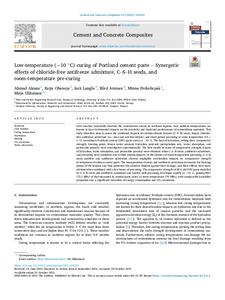Low-temperature (−10 °C) curing of Portland cement paste – Synergetic effects of chloride-free antifreeze admixture, C–S–H seeds, and room-temperature pre-curing
Alzaza, Ahmad; Ohenoja, Katja; Langås, Isak; Arntsen, Bård; Poikelispää, Minna; Illikainen, Mirja (2022-01)
Alzaza, Ahmad
Ohenoja, Katja
Langås, Isak
Arntsen, Bård
Poikelispää, Minna
Illikainen, Mirja
01 / 2022
104319
Julkaisun pysyvä osoite on
https://urn.fi/URN:NBN:fi:tuni-202111188519
https://urn.fi/URN:NBN:fi:tuni-202111188519
Kuvaus
Peer reviewed
Tiivistelmä
Cold weather drastically shortens the construction season in northern regions. Low ambient temperatures are known to have detrimental impacts on the reactivity and hardened performance of cementitious materials. This study therefore aims to assess the combined impacts of calcium silicate hydrate (C–S–H) seeds, binary chloride-free antifreeze admixture (i.e., urea and calcium nitrate), and short-period precuring at room temperature (23 ± 1 °C) on ordinary Portland cement (OPC) paste-cured at −10 °C. The heat of hydration, setting time, compressive strength, freezing point, frozen water amount, hydration products precipitation rate, water absorption, and permeable porosity were investigated experimentally. The best results in terms of compressive strength, degree of hydration, water absorption, and permeable porosity were obtained when C–S–H seeds, antifreeze admixture, and precuring were combined due to their mutual impacts. In the absence of room-temperature precuring, C–S–H seeds additive and antifreeze admixture showed negligible acceleration impacts on compressive strength development of subzero-cured paste. The incorporation of seeds and antifreeze admixture decreased the freezing points of the binders and thus protected the admixed binders against frost damage, and their effects were more obvious when combined with a few hours of precuring. The compressive strength of 28 d-old OPC paste modified by C–S–H seeds and antifreeze admixture and treated with precuring developed rapidly at −10 °C, gaining 96% (75.1 MPa) of that measured in control paste cured at room temperature (78 MPa), with comparable durability properties and a significant reduction of energy consumption and CO2 emissions.
Kokoelmat
- TUNICRIS-julkaisut [16983]
